Change Leadership: How to Lead Change as a Change Leader

8 Mins
Updated: October 31, 2025
Published: July 23, 2024

Change is inevitable, but positive transformation starts with good leadership. Organizations thrive or flounder based on their ability to adapt. And steering professionals through change successfully requires the right resources and competent change leadership.
Effective Change Leadership
Mastering change leadership is a must-have for leaders steering enterprise-level transformations. Constant change is chaotic, but strong leadership can be a positive experience. The research speaks for itself.
The Prosci Best Practices in Change Management report reveals that strong change leadership for managing the people dimension of change is a top contributor to organizational success. Yet few leaders feel fully equipped to shepherd their employees through the change process.
Correlation Between Effective Change Management and Success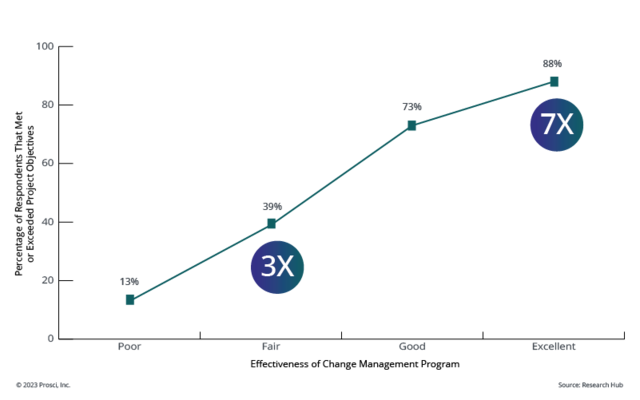
Here, we'll discuss change leadership's crucial but often overlooked role. We'll share helpful insights and provide frameworks that empower you to become a successful change leader. You can use these insights to significantly shorten your learning curve to become an effective change leader and catalyst for your organization.
What Is Change Leadership in Organizational Change?
Executives and senior leaders usually act as the primary sponsors of change. Primary sponsors are the ones who initiate the change and ensure its successful implementation. These sponsors will drive the change, allocate resources, and lead by example.
For wide-reaching changes, a primary sponsor may involve additional leaders to help implement change throughout the organization. Let's understand the key players who choreograph change in an organization:
- Change practitioners and project managers architect the transition behind the scenes by planning and setting the stage.
- Sponsors and people managers champion the change on the front lines, directly interacting with employees—guiding and supporting them through the transition and minimizing disruption.
The depth of sponsorship required varies with the risk level of the change. High-risk changes, such as mergers and acquisitions, require top executives as primary sponsors, while senior or mid-level managers will often manage lower risks. Leaders must excel in their change leadership role to ensure the change is successful while inspiring employees about the changes happening.
Considering the challenges driving change, you can’t do it alone. But with the right approach and tools, you can master change leadership to better your organization's adaptability and resilience.
Change Leadership vs. Change Management
Change leadership and change management are crucial partners in guiding organizational change, but the two have subtle differences:
- Change management focuses on structured processes and how to help people adopt and use implemented changes. It involves change practitioners, project managers and people managers systematically working to engage employees and guide them through new workflows and behaviors.
- Change leadership revolves around visionary leadership and emotional intelligence. It ignites a cultural shift and propels the organization toward its new vision. This requires active engagement from primary sponsors and other sponsors playing a pivotal role in supporting the change. For example, during a merger, the CEO and senior leaders openly discuss employee concerns and the benefits of joining forces with another company. To get the buy-in and commitment needed for success, they listen to employee concerns, share information clearly, and adjust plans to keep everyone on board and focused on making the merger work. This approach helps everyone feel understood, motivating them to participate in the transition actively.
Leaders drive change leadership by actively participating, building sponsorship coalitions, and communicating directly with the workforce to ensure the change is understood and embraced at all levels.
Primary sponsors work closely with other sponsors, change practitioners, project managers and people managers. This team unites structured change management with the motivational power of change leadership.
Together, they implement change and embed it deeply within the organization. This integration creates an adaptable and resilient organizational culture.
What Is the Role of Leaders in Change Management?

According to the Prosci Methodology, these are the core roles that help make change management successful:
Sponsors are typically senior executives or leaders who authorize change and are responsible for change. They perform the critical ABCs of sponsorship:
- Active and visible participation
- Building a coalition
- Communicating support for the change
In addition to primary sponsors, sponsor coalitions make change efforts work better. They do this by fully supporting the change in their areas of the organization, discussing it clearly, and ensuring it fits well with the company's culture. In addition to supporting change leadership development in peer leaders, coalitions enable organizations to get people on board while understanding people's feelings.
Building on this foundation:
Change practitioners work behind the scenes. Smart planning and efficiently coordinating activities helps to ensure the change goes smoothly. They help others get ready for the change, too. In addition to developing the change management strategy and plans, change practitioners prepare and coach sponsors and people managers to perform their roles during change.
Project managers take care of the technical parts of change, like ensuring any new systems or updates are done right. If a company is getting new IT systems, a project manager ensures everything from installing new software to training people is planned well and helps the company work better.
People managers are the supervisors who look after employees day-to-day and help them through changes. They're the ones who make sure their teams understand the change and deal with any problems that come up, using their skills to communicate, connect, support, handle resistance, and guide their organization.
Employees are the recipients or end users. Their engagement and willingness to adopt new ways of working are crucial for the change's success.
It's important to differentiate between the roles of sponsors and people managers to ensure everything is clear.
In some cases, people managers might also be senior leaders, especially in smaller organizations, where they need to perform both strategic and tactical roles in change management.
Core Roles in Change Management
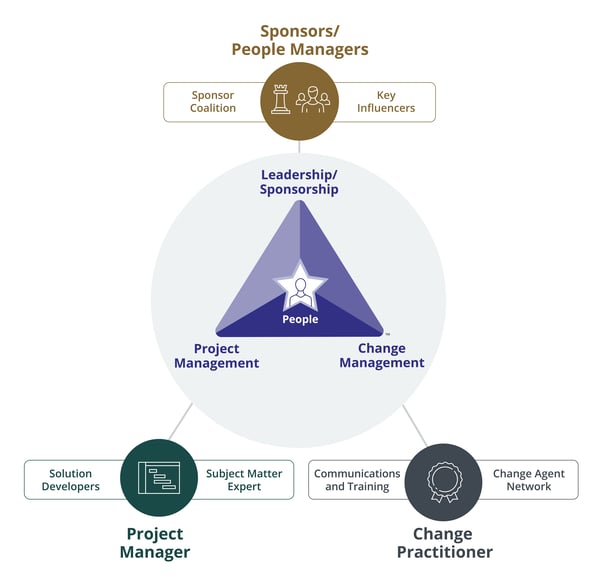 Why Is Change Management Important in Leadership?
Why Is Change Management Important in Leadership?
Modern businesses demand effective change management and make it part of leadership development. The role of executives and senior leaders as primary change sponsors is critical. As champions of new initiatives, they provide vital resources and credibility to ensure the change is successful and aligned with organizational goals.
Prosci research consistently shows active, visible sponsorship as a top contributor to the success of change initiatives.
Conversely, the absence of effective sponsorship is one of the biggest obstacles—hindering progress and spurring resistance. Some risks of poorly managing change include project failure or delays, budget overruns, reduced work quality, employee attrition, and so on.
Correlation of Sponsor Effectiveness With Meeting Objectives
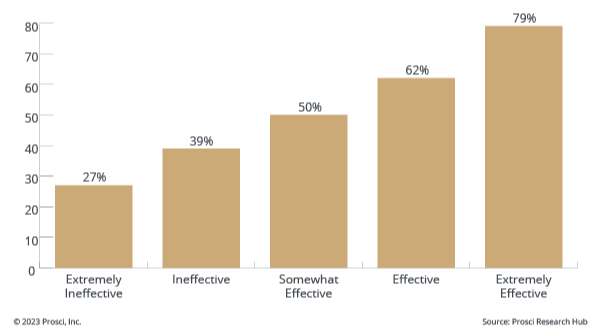
The ABCs of effective sponsorship during change initiatives
According to Prosci research on Best Practices in Change Management, the executive sponsors need to fulfill the roles below:
- Active and visible participation – The most frequent activity cited for primary sponsors is their active and visible participation throughout a project.
- Building a coalition of sponsorship – A primary sponsor must lead the formation of a robust sponsor coalition. This involves mobilizing other key leaders and stakeholders to support and legitimize the change across the organization.
- Communicating support and promoting change – Senior leaders are crucial in conveying the business reasons for change, emphasizing its importance and addressing the risks of not adapting. Their direct engagement with employees helps in setting priorities and to improve change leadership.
Start out early as change leaders
Prosci studies show that leaders starting change management initiatives early in a project can significantly enhance the outcomes. Senior leadership involvement and prior experience in change management are pivotal in this early initiation.
Correlation Between When Change Management Starts and Meeting or Exceeding Project Objectives
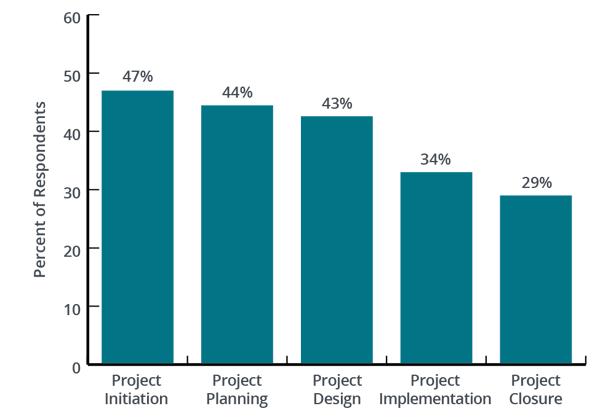
Prosci research has consistently shown a direct correlation between the timing of when change management is initiated in a project and the project's success:
- 97% of participants in the study recommended starting change management during either the initiation or planning stages of a project.
- Projects that started change management at the initiation stage were more successful, with 47% of participants reporting that their projects met or exceeded objectives.
- Only 29% of participants who started change management at the closure stage reported meeting or exceeding project objectives.
Effectively communicate and prioritize employees during change
The company's priority is supporting team members during unexpected challenges. Cultivating a resilient organizational culture with clear and transparent communication about who is impacted and to what degree is paramount.
The Prosci Best Practices in Change Management - 12th Edition study reveals that employees value change messages from two key figures, namely, their direct supervisors and top leaders. Supervisors are favored for details about personal impacts of a change. Executives and senior leaders are preferred senders for messages about business-related impacts. This underlines how diverse, tailored leadership communication during change is key.
Preferred Senders of Messages
.webp?width=700&height=525&name=Blog%20Images-PreferredSenders-Callouts%20(2).webp)
Consider the risks of poorly managed change
The cost of poorly managed change can be disastrous, ranging from project delays and budget overruns to reduced employee morale and overall organizational decline.
Risks of Poorly Managed Change
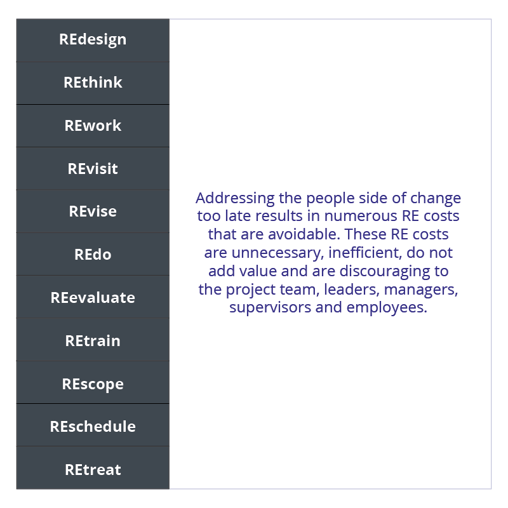
Strategies for Successful Change Leadership
Effective enterprise change leadership takes a comprehensive approach, aligning with business goals to nurture organizational agility.

Next, we'll discuss five key strategies for leading change and explain them using a made-up hospital, Health Able, as an example. This hospital uses a new electronic system to keep patient records to make care better and more efficient.
- Aligning change with business strategy – Aligning change initiatives with broader business objectives ensures that changes contribute to the organization's long-term goals. Primary sponsors give the changes credibility by driving them from the top.
Example: The chief medical officer ensures that the implementation of electronic health records (EHR) supports the hospital's goal of enhancing patient privacy and quality of care. - Promoting adaptability – Building an adaptable culture involves encouraging employees to be open to change. This cultural shift needs support across the organization, where different roles—from executives to front-line employees—work together in accepting and implementing change.
Example: Engaging staff in the change increases their commitment to it because they feel some ownership. Regular training sessions ensure all staff members are equipped to adopt and use the new system in their daily work. - Investing in employee development – Developing employee skills is a crucial step toward change preparation. Companies that invest in employee development show their commitment to growth.
Example: Health Able provides comprehensive training programs to help staff members use the EHR system effectively. Ongoing education opportunities keep staff updated on best practices and new features. - Leading by example – Setting a tone of change through behavior, commitment and involvement to be a powerful role model for the rest of the organization.
Example: Hospital leadership actively engages with the EHR system and encourages staff to embrace the change. - Encouraging open, two-way communication – Communicating the vision and rationale for change and providing a platform for feedback and discussion.
Regular town hall meetings and feedback sessions address staff concerns and gather input on the EHR implementation. An online platform allows staff to submit questions and suggestions, promoting transparency and dialogue.
Together, these strategies tackle the many dimensions of change—from strategic alignment and culture to communication and capabilities. Deployed in depth across the organization, they can empower enterprises to navigate change with agility, leading to sustainable business outcomes.
How Do Good Leaders Manage Change?
Good leaders manage change by blending strategic oversight and empathetic engagement.
A key example is the global expansion of Prosci under the guidance of its Chief Global Officer, Mark Dorsett. Here are some lessons we can take from Dorsett's leadership:
Effective leadership requires active and visible executive sponsorship
- Goes beyond decision-making and budget control
- Is crucial for the success of global expansion efforts
Removing barriers to change takes a strategic leadership approach
- Direct, one-on-one interactions with country and in-market leaders
- Creates a strong sense of connection and open communication channels
Leadership roles focus on the ABCs of sponsorship
- Focuses on removing hierarchical barriers
- Encourages open dialogue to navigate new market challenges and cultural integrations
What Is the Role of People Managers in Change Management?
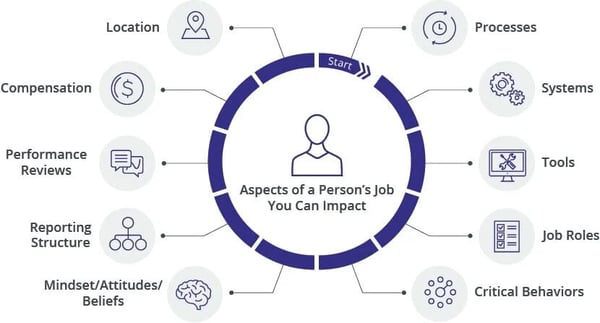
People managers are the primary link between the change initiative and front-line employees. They thrive under structured processes like the Prosci ADKAR® Model. ADKAR stands for Awareness, Desire, Knowledge, Ability and Reinforcement.
People managers are crucial to implementing the five CLARC Roles effectively:
- Communicator – Aligning with the Awareness stage, people managers inform their teams about the change, addressing questions like "What’s in it for me?" and "Why should I get on board?"
- Liaison – In the Reinforcement stage and throughout the change, managers act as connectors between the project team and employees, ensuring a feedback loop that supports and sustains the change.
- Advocate – Corresponding with the Desire stage, they build a supportive environment, encouraging their organization to embrace the change.
- Resistance Manager – This role contributes to both the Desire and Reinforcement stages by identifying and mitigating resistance, proactively addressing barriers and concerns.
- Coach – Focusing on the Knowledge and Ability stages, managers provide guidance, training and support, enabling employees to acquire the skills necessary for the change.
The Prosci ADKAR Model
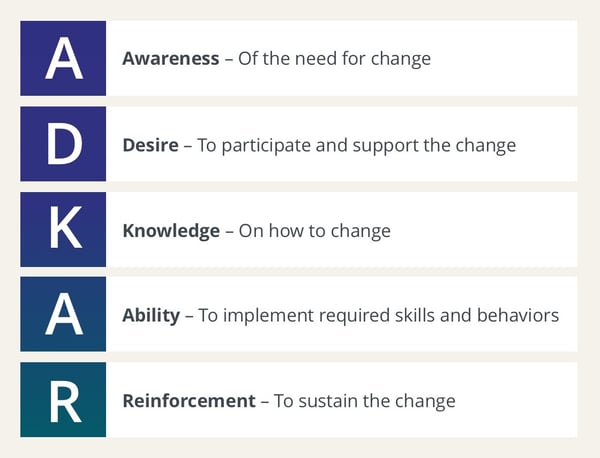 If you're a people manager, you can use this worksheet to document how you’ll help your employees advance through the Prosci ADKAR Model.
If you're a people manager, you can use this worksheet to document how you’ll help your employees advance through the Prosci ADKAR Model.
Many organizations fall short in preparing people managers for these roles. Change practitioners must ensure that people managers understand their responsibilities and prepare with the necessary skills and tools.
Prosci Change Management Process for Managers and Supervisors
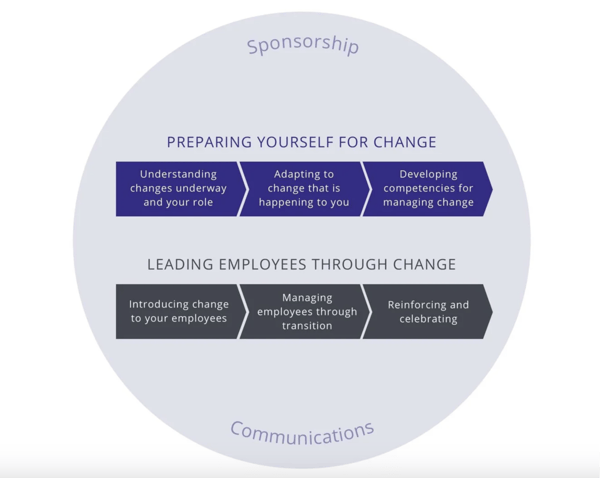
Leveling Up Change Leadership Skills and Moving Forward
Guiding individuals through change while promoting adaptability is key to successful change leadership. The links between effective change leadership, strategic vision, and organizational success are clear and undeniable. By cultivating agility, transparency and fierce commitment, you can empower employees to embrace change initiatives in your organization.




